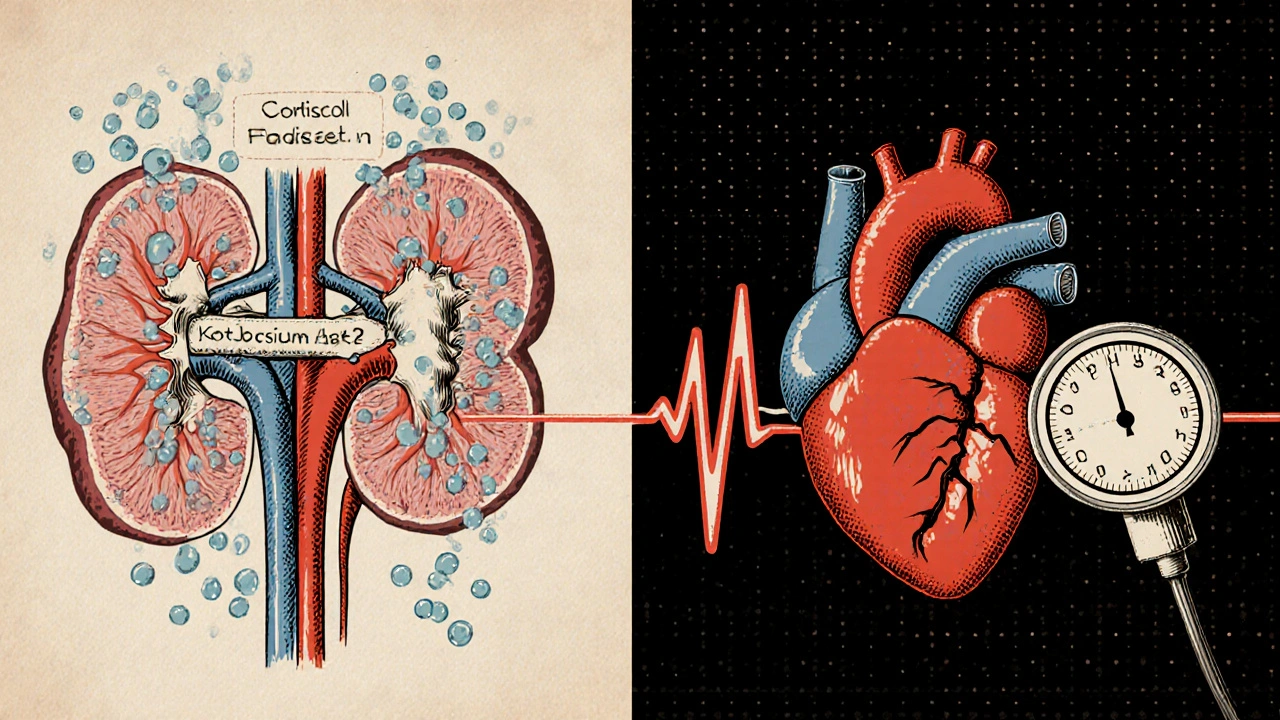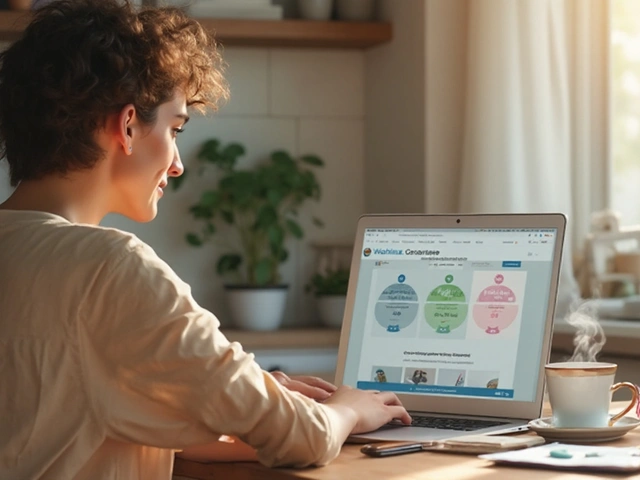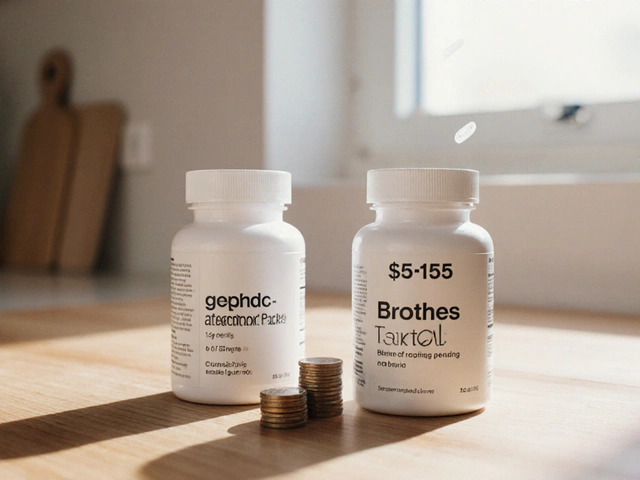Licorice and Blood Pressure Medication Interactions: What You Need to Know
Have you ever reached for a piece of black licorice candy when you’re stressed? Or sipped on licorice tea thinking it’s just a soothing herbal drink? If you’re taking medication for high blood pressure, that habit could be quietly undoing your treatment - and putting your heart at risk.
How Licorice Tricks Your Body
Licorice root isn’t just a flavor. The real troublemaker is a compound called glycyrrhizin. When you eat or drink it, your body breaks glycyrrhizin down into glycyrrhetic acid. This metabolite shuts down an enzyme in your kidneys called 11β-HSD2. That enzyme normally protects your body from cortisol - a stress hormone that acts like aldosterone, a hormone that makes your kidneys hold onto salt and water while flushing out potassium. When 11β-HSD2 is blocked, cortisol takes over. Your kidneys start behaving as if they’re flooded with aldosterone. Result? You retain extra fluid. Your blood volume goes up. Your blood pressure rises. At the same time, you lose potassium - sometimes dangerously low levels. This isn’t a myth. It’s a well-documented physiological effect that’s been studied since the 1950s. And it doesn’t take much to trigger it. Consuming more than 100 milligrams of glycyrrhizin per day - roughly the amount in 60 to 70 grams of black licorice candy - can cause measurable changes in blood pressure and potassium levels within just two to four weeks.Why This Matters for Blood Pressure Meds
If you’re on medication to lower your blood pressure, your body is trying to get rid of excess fluid and relax your blood vessels. Licorice does the exact opposite. It adds fluid, tightens vessels, and lowers potassium - all things your meds are trying to fix. This interaction hits every class of blood pressure medication - but some are more vulnerable than others.- Diuretics like hydrochlorothiazide already make you lose potassium. Add licorice, and your potassium drops even lower - increasing your risk of muscle cramps, irregular heartbeat, and even heart failure.
- ACE inhibitors and ARBs work by relaxing blood vessels and reducing fluid. Licorice floods your system with fluid, making these drugs less effective. Your blood pressure might stay high even though you’re taking your pills every day.
- Potassium-sparing diuretics like spironolactone are meant to keep potassium up. But licorice forces potassium out anyway. It’s like turning on a faucet while trying to plug a leak.
- Digoxin (Lanoxin) is especially dangerous. Low potassium makes your heart more sensitive to digoxin. That can lead to toxic levels, causing nausea, confusion, and life-threatening arrhythmias. There are documented cases of older adults ending up in the hospital with heart failure after eating licorice while on digoxin.
What Counts as Too Much Licorice?
Not all licorice products are the same. Many modern candies labeled "licorice" are actually flavored with anise oil and contain zero glycyrrhizin. That’s fine. But traditional black licorice - especially the chewy kind - often contains real licorice root extract. Here’s what 100 mg of glycyrrhizin looks like in real life:- 60-70 grams of black licorice candy (about 2.1-2.5 ounces)
- 1-2 cups of licorice tea made from root
- One or two daily doses of licorice root supplements

Who’s at Highest Risk?
Some people are more sensitive to glycyrrhizin than others. You’re at higher risk if:- You’re over 60
- You’re female
- You already have high blood pressure
- You have heart disease or kidney problems
- You’re taking digoxin or diuretics
Signs You Might Be Having a Reaction
If you’re taking blood pressure meds and start noticing any of these, consider licorice as a possible cause:- Your blood pressure suddenly goes up, even though you’ve been consistent with your meds
- You feel unusually tired, weak, or have muscle cramps
- You notice swelling in your ankles or feet
- Your heart feels like it’s skipping beats or racing
- You’re urinating more than usual
What Should You Do?
If you’re on blood pressure medication:- Stop eating black licorice candy. Read labels. If it says "licorice extract" or "Glycyrrhiza glabra," avoid it.
- Check your teas and supplements. Many herbal laxatives, digestive teas, and "adaptogen" blends contain licorice root. Look for alternatives without it.
- Talk to your doctor. Tell them if you’ve been consuming licorice - even occasionally. They may want to check your potassium and blood pressure more closely.
- Don’t assume "natural" means safe. Herbal doesn’t mean harmless. Licorice is a potent bioactive compound with real drug interactions.
The Bigger Picture
This isn’t just about candy. It’s about how we think about supplements and "natural" remedies. People assume that because something comes from a plant, it’s safe to mix with prescription drugs. But plants contain powerful chemicals - and licorice is one of the most clinically significant food-drug interactions in medicine. The FDA doesn’t require manufacturers to list glycyrrhizin content on supplements. That means you’re flying blind. A bottle labeled "licorice root extract" could be a silent threat. Doctors now routinely ask patients with uncontrolled high blood pressure: "Do you eat licorice?" If the answer is yes - even once a week - it’s often the missing piece in their treatment puzzle.Alternatives to Licorice
If you miss the sweet, earthy flavor, try these safe swaps:- Anise-flavored candy - tastes similar, no glycyrrhizin
- Roasted chicory root tea - rich, slightly sweet, no blood pressure effects
- Dandelion root tea - naturally sweet, supports liver and kidney function
- Stevia or monk fruit - zero-calorie sweeteners with no known drug interactions
Final Takeaway
Licorice isn’t just a flavor. It’s a hormone disruptor with real, measurable effects on your blood pressure and heart. If you’re taking medication to control hypertension, even small, regular amounts can sabotage your treatment - and put you at risk for serious complications. Don’t wait for symptoms to appear. If you’re unsure whether your candy, tea, or supplement contains glycyrrhizin, assume it does - and choose something else. Your blood pressure and your heart will thank you.Can I eat licorice if I have high blood pressure?
No. If you have high blood pressure, you should avoid licorice root products entirely. Glycyrrhizin in licorice causes your body to retain salt and water, which raises blood pressure and can make your medications less effective. Even small amounts over time can lead to uncontrolled hypertension.
How much licorice is dangerous?
More than 100 milligrams of glycyrrhizin per day is considered risky. That’s about 60-70 grams of black licorice candy - roughly two to three handfuls. But some people, especially older adults and women, can react to even lower doses. If you’re on blood pressure meds, it’s safest to avoid it completely.
Is red licorice safe?
Yes, red licorice is usually safe. Most red licorice candies are flavored with anise or artificial flavors and do not contain licorice root or glycyrrhizin. Always check the ingredient list - if it says "licorice extract," avoid it. If it only lists sugar, corn syrup, and flavorings, it’s fine.
Does licorice tea raise blood pressure?
Yes, if it’s made from licorice root. A single cup of licorice root tea can contain 10-50 mg of glycyrrhizin. Drinking it daily - even one cup - can build up to dangerous levels over time. Opt for herbal teas like chamomile, peppermint, or rooibos instead.
Can licorice cause low potassium?
Yes. Glycyrrhizin causes your kidneys to excrete potassium, leading to hypokalemia (low potassium). Levels can drop by 0.5 to 1.0 mmol/L with regular consumption. This increases the risk of muscle weakness, irregular heartbeat, and dangerous interactions with medications like digoxin.
Should I stop taking my blood pressure meds if I eat licorice?
Never stop your blood pressure medication without talking to your doctor. Instead, stop consuming licorice and let your doctor know. They may check your potassium and blood pressure levels and adjust your treatment if needed. Stopping your meds on your own can be dangerous.
Are there any safe licorice products?
Yes - products labeled "deglycyrrhizinated licorice" (DGL) have had the glycyrrhizin removed. These are sometimes used for stomach issues and are generally safe for people on blood pressure meds. But always check the label and confirm with your doctor before using any licorice-derived product.







9 Comments
Kihya Beitz
November 16, 2025 at 08:37
So let me get this straight - I can’t have my daily licorice stick because some lab rat in a 1950s study said so? Cool. I’ll just keep drinking my licorice tea while my BP climbs and my heart does the cha-cha. At least I’m happy. 🤷♀️
Jennifer Walton
November 16, 2025 at 21:43
Nature doesn’t care about your prescriptions. It just is. Glycyrrhizin isn’t evil - it’s just doing its job. You’re the one who decided to weaponize a root.
Jessica Chambers
November 18, 2025 at 06:30
I just checked my candy bag. 🙃 Turns out I’ve been eating ‘licorice’ for 3 years… and it’s just sugar, corn syrup, and ‘natural flavor.’ So… I’m fine? Right?
Shyamal Spadoni
November 19, 2025 at 09:37
This is all a Big Pharma psyop. They don’t want you to know that licorice is the REAL cure for hypertension - but they’ve been suppressing the data since the 70s. Why do you think the FDA won’t label glycyrrhizin? Because they’re paid by AstraZeneca. I read it on a forum. My cousin’s neighbor’s dog got diagnosed with low K+ after eating licorice. Coincidence? I think not.
Ogonna Igbo
November 20, 2025 at 10:59
In Nigeria we use licorice root to treat high blood pressure - not cause it. You Westerners overthink everything. Your meds are poison. Our herbs work. Why do you trust a pill from a lab more than a root from the earth? This is cultural imperialism wrapped in a medical paper.
BABA SABKA
November 20, 2025 at 21:21
Let’s be real - glycyrrhizin is a potent bioactive compound. The real issue isn’t the candy, it’s the lack of pharmacovigilance in the supplement industry. You’ve got unregulated products with variable glycyrrhizin content being sold as ‘herbal wellness.’ That’s a regulatory failure, not a personal failing. We need mandatory labeling - not fearmongering.
Chris Bryan
November 22, 2025 at 12:15
They’re coming for your licorice next. First it’s sugar, then caffeine, now this. Next they’ll ban chocolate because of theobromine. They want you weak. Dependent. On their pills. Don’t fall for it. Eat the licorice. Fight back.
Jonathan Dobey
November 22, 2025 at 15:41
Ah yes - the sacred cow of ‘natural’ remedies, now being dissected by the clinical gaze. How poetic. Licorice root, once revered by Hippocrates and Tibetan monks, now reduced to a ‘glycyrrhizin payload’ in a FDA footnote. We’ve turned alchemy into algorithm. We’ve sterilized the soul of the plant. And for what? To make your beta-blockers work better? I’d rather have a hypertensive crisis than live in a world where everything is a drug interaction.
ASHISH TURAN
November 22, 2025 at 20:19
I’m on lisinopril and I used to drink licorice tea every morning. Didn’t know until my doctor asked. Got my K+ checked - was at 3.2. Stopped the tea. Two weeks later, back to 4.1. No drama. Just simple. Don’t overthink it. If your med’s working, don’t sabotage it with something you don’t understand. Simple as that.